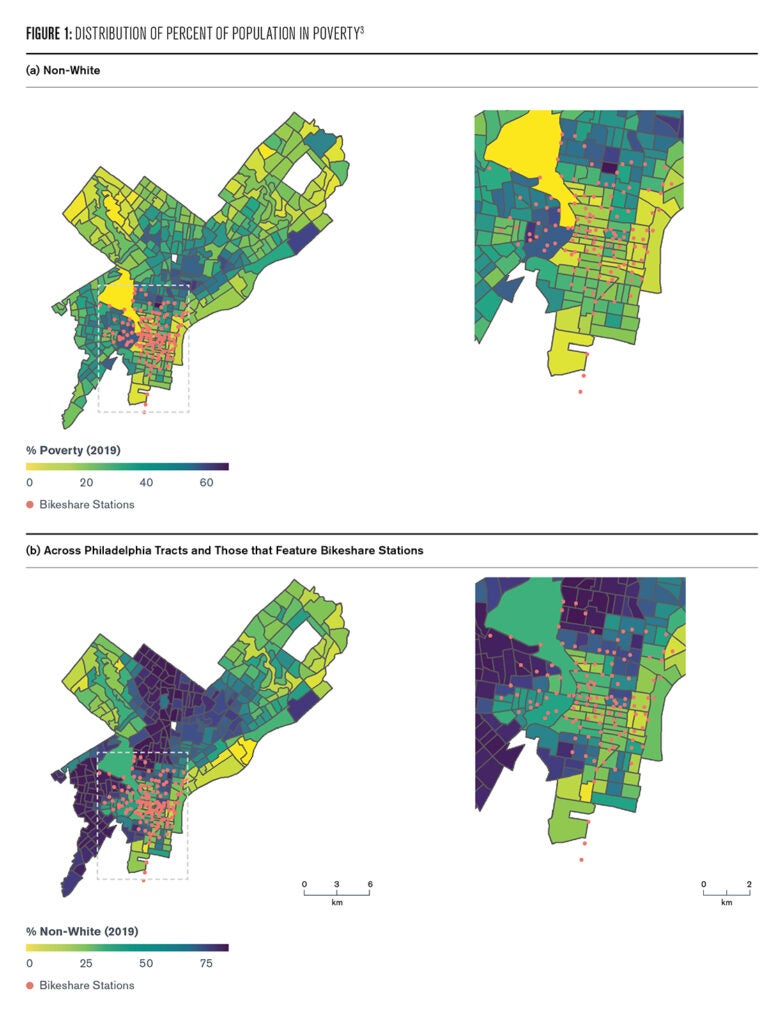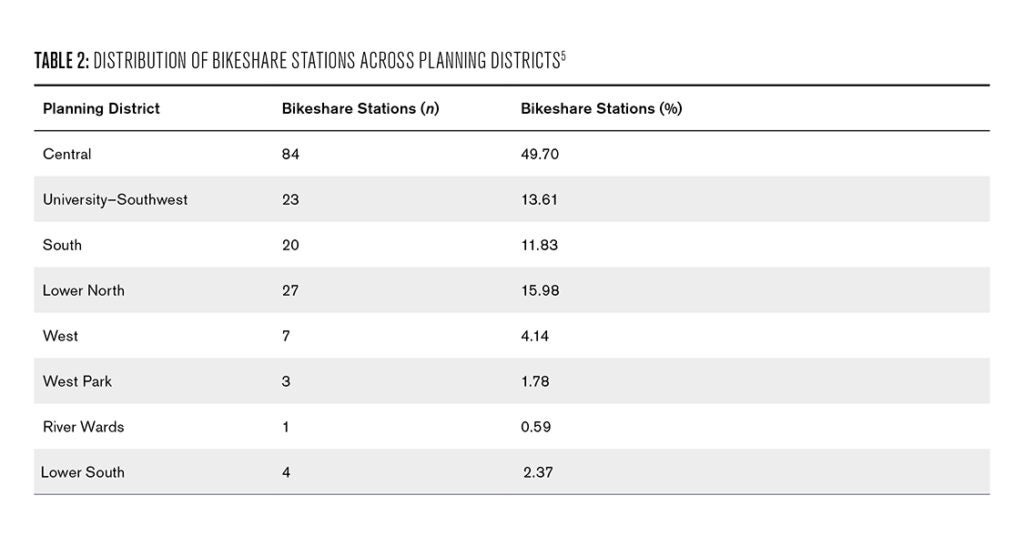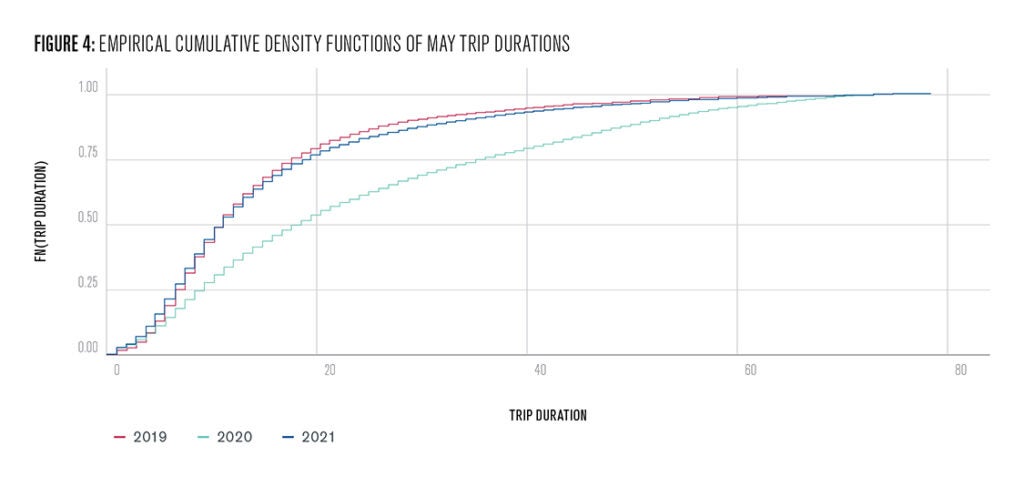Opportunities to Equitably Expand Bikeshare: Learning from the Covid-19 Period

Bikeshare systems are historically thought to be used predominantly by white, middle-class populations. This digest looks at bikeshare use patterns during the Covid-19 pandemic and finds substantially increased use among more diverse populations, signaling new opportunities for equity-oriented bikeshare policy in the future.
At a Glance
Key Challenge
Bikeshare user demographics have been notoriously hard to shift through equity-oriented programs.
Policy Insight
Diverse users increased the use of bikeshare during the pandemic in dramatic ways that suggest ways to better serve diverse populations in the future.
This policy digest is adapted from “New Equity Inputs to Prioritize Bikeshare Infrastructure Allocation: Learning From the COVID-19 Period” originally published in the Transportation Research Record: Journal of the Transportation Research Board and “A Socio-Spatial Approach to Define Priority Areas for Bicycle Facilities Using Covid-19 Data” under review.
Introduction
Bikeshare programs have been lauded for their capacity to generate benefits across diverse policy areas including health, mobility, and environmental impact (Fishman 2016; 2020). Yet, scholars have also highlighted the substantive barriers to the use of bikeshare by diverse members of the public, particularly low-income and/or minority populations (Fishman 2016; McNeil et al. 2017; Shaheen, Guzman, and Zhang 2010).
While bikeshare users are likely more diverse than other cyclists across the metrics of gender (Wang and Akar 2019), income, and race/ethnicity, they still remain more white, higher income, and male than the general population (Buck et al. 2013). As bikeshare systems have grown exponentially over the last two decades (Fishman and Shaheen 2021), it is imperative that system operators, infrastructure offices, and city governments work to distribute the benefits of bikeshare broadly across the population.
Successful policy interventions that serve low-income and minority communities through bikeshare have been difficult to craft and hard to implement (McNeil et al. 2017; Howland et al. 2017). Programs such as reduced fares, extended hours of service, or trial memberships, have not substantively increased use by target population groups. Furthermore, low-income areas that do feature bikeshare stations tend to generate fewer trips than higher income areas (Caspi and Noland 2019).
However, it is quite difficult to determine the rationale behind this lack of engagement. It is unclear in the existing scholarship and policy environment whether bikeshare as a system is not appealing to low-income and minority populations, or, if given the right kind of policy intervention and spatial distribution of service, bikeshare systems could provide an attractive mobility option that builds greater accessibility for low-income and/or minority groups.
The onset of the Covid-19 pandemic offers a unique opportunity to test whether the dominant socioeconomic and demographic character of bikeshare users as more white and higher income is persistent, or, conversely, if use patterns exhibit more diversity in response to such a dramatic, exogenous event.
The beginning of the pandemic immediately affected mobility across the totality of the population, who had diverse mobility practices and were able to respond to the pandemic in different ways. For example, white-collar workers were able to work remotely while blue-collar and essential workers had to continue commuting. Therefore, the effect size of the pandemic as such a uniform and total event, can shed light on how different populations changed their use of bikeshare services.
The character of changes in bikeshare use during the pandemic can particularly help orient future policy that promotes more equitable and diverse bikeshare programs. If, during the Covid-19 pandemic, bikeshare use changed in ways that led only to sustained or greater use in high-income and/or white areas, this would suggest that the existing bikeshare system supports travelers with an already high disposition towards bikeshare, but is unable to support the needs of diverse users in a time of crisis.
However, if use patterns during the pandemic shift in ways that exhibit positive changes across more socio-economic and demographically diverse geographies, this would suggest that diverse users found benefits in this system during the crisis.
In the later scenario, bikeshare can provide a necessary mobility service—supplying a wide range of the population with a low-cost, non-energy intensive option in a time of need—an example operators and policymakers should work to build on.
In the following analysis, we describe how the dynamics of the Covid-19 pandemic may have altered the dominant socioeconomic and demographic use patterns that historically characterize bikeshare systems.
- We measure the effect of the onset of the Covid-19 pandemic on one key metric, average daily bikeshare trip durations, using the case study of the Indego bikeshare system in Philadelphia.
- We employ this key metric in modeling frameworks to assess change across diverse populations during the pandemic period. Changes are first analyzed at the system-wide level to determine whether average trip durations changed substantially during the Covid-19 period.
- We look at subsets of the data based on the geographic location of bikeshare stations. At this stage, we group the data based on Philadelphia’s planning districts, which are highly varied socio-economic and demographic areas of the city.
Our results demonstrate that the effect of the Covid-19 pandemic on trip duration is substantial and positive both at the system level, and, across all the planning districts we analyzed. Together, these findings signal that diverse populations increased bikeshare travel times in essentially the same way during the pandemic, which suggests that bikeshare provided necessary mobility during the crisis. Planners can build on this example by expanding the opportunities to utilize bikeshare services across more diverse geographies and thereby build on the positive energy generated around bikeshare use during the pandemic.
Philadelphia: An ideal Case Study
Philadelphia’s bikeshare system provides an ideal case study to investigate the opportunities for equitable expansion of transportation services. First and foremost, the Indego system, from its inception, has considered equity to be at the forefront of its planning concerns (Krykewycz et al. 2010; Howland et al. 2017). Second, Philadelphia features a highly racially and socioeconomically segregated geography, as reflected in the populations that constitute the city’s planning districts (Table 1 and Figure 1). In the last two years, the Indego system has undergone a substantial geographic expansion, including locating new stations in more outlying, low-income, and minority areas (Pulcinella 2021). Nonetheless, third, the dominant distribution of bikeshare stations across Philadelphia exhibits a skewed concentration in higher income and more white areas of the city.
The spatial distribution of stations across census tracts and planning districts is presented in Figure 21. Substantial areas of Philadelphia have no bikeshare stations, including the entirety of Northeast and Northwest Philadelphia, and much of North and Southwest Philadelphia, as well. In the areas that do feature stations, they exhibit patterns of clustering near Center City, Philadelphia’s commercial and government center. Almost half of all bikeshare stations are found in the Central district, and greater than 40% of stations are located districts that directly border Center City (Table 2).




Pandemic Period Bikeshare Use
Bikeshare use, as reflected by trip durations, changed dramatically in Philadelphia during the Covid-19 pandemic, particularly at the outset of the public health crisis in spring/summer 2020. The substantial increase in trip durations at the beginning of the pandemic are shown in the time series plots in Figure 3, in average bikeshare trip durations for both the overall Indego system and for each planning district.
It is important to note that use patterns differ across planning districts, which are reflected in the range of trip duration values (on the y axis) across the district level plots in Figure 3b. Nonetheless, the general trends regarding bikeshare use and the pandemic are clear; there is a very large increase in trip duration at the outset of public health interventions (lockdowns, quarantine, etc.) initiated in response to the COVID-19 pandemic. This increase is consistently present across different planning districts that are typified by stark differences in race and socioeconomic status. This dramatic increase is sustained across the summer of 2020, with growth slowing down by fall 2020 and returning roughly to pre-pandemic patterns in 2021, as public health interventions eased with the onset of vaccination.

By zooming in on bikeshare trips taken in the month of May, which we found to be the month with the longest trip durations on average (Davidson et al. 2022), we can see even more clearly the extent to which early pandemic use differed from baseline conditions. In the empirical cumulative density functions for trip duration, 2020 trips display noticeably different distributions than either 2019 or 2021. For example, the 75th percentile for trip duration (which can be determined by locating 0.75 on the y axis and the corresponding value at the point on the x axis for trip duration) is 40 minutes in 2020, roughly double that value for 2019 and 2020 (see Figure 4).

The results of time-series regression models that investigate the effect of the pandemic on bikeshare trip durations in Philadelphia reinforce the visual findings in Figure 3 (model results not presented here (see Davidson et al. 2022)). The effect of the pandemic is highly statistically significant and associated an increase of approximately 7.46 minutes on trip durations across the Indego system. The effect of the pandemic on trip durations was also positive and highly statistically significant across each of the planning districts, ranging from about 5 minutes (West Park) to around 12.5 minutes (Lower South).
Together, these results reinforce the finding that the pandemic led to substantial increases in bikeshare use, and that this increase manifested across quite diverse population groups. Recall that the socioeconomic and demographic nature of each district differs greatly from one another, and that there was a substantive level of variability and volatility in bikeshare use patterns across the districts in the pre-pandemic period. The stable and constant impact of the pandemic, as described in the regression results, suggests a strong and consistent trend; irrespective of population characteristics, bikeshare use increased substantially in the pandemic.
Implications for Bikeshare Policy
The results of this analysis signal that that low-income and high-minority populations displayed a high likelihood to increase bikeshare use during the pandemic, reflecting the general population increase in bicycle use overall during this period (Buehler and Pucher 2021). This finding suggests that any previous dis-propensity to use bikeshare by such populations in the past may be more likely due to policy frameworks rather than a dis-propensity to travel by bicycle.
Our findings importantly foreground that low socioeconomic and minority populations could garner increased accessibility through bikeshare if programmatic system expansions locate specifically in more distant geographic areas beyond the existing reach of the system. We glean from these findings that bikeshare systems are already, and can grow further into an increasingly prominent, affordable, and non-energy intensive choice among mobility options.
We suggest three specific ways that bikeshare operators can build on the examples of use during the pandemic:
- Better understand changes in use during the pandemic. Broad-based growth in bikeshare use at the outset of the pandemic is an important motivation for bikeshare operators and policymakers to think of their systems as a necessary mobility service. Such actors will be able to understand how their systems are chosen and utilized better by growing their knowledge of user characteristics and choices. To infer implications among such a diverse population of users, we recommend qualitative interviews to better understand what led to the kinds of dramatic changes in use during pandemic, which can in turn be employed to bolster policies that support expanded use.
- Build synergies with safe infrastructure. Among the myriad changes to society during the pandemic, the public health crisis allowed public agencies to quickly enact programs to support recreating in a socially distant fashion that were also exemplar cases of safe infrastructure. The closure of Martin Luther King Drive is the most prominent example of this phenomenon in Philadelphia. The 4.5-mile roadway before the pandemic functioned generally as an auxiliary to Interstate 76, and featured almost entirely motorists, often travelling at unsafe speeds. After the closure to automobiles at the beginning of the pandemic, MLK became one of the most used cycling and pedestrian paths in the state of Pennsylvania (LoBasso 2020). We believe that some of the trip duration increases during the pandemic were in response to these major infrastructure interventions. Bikeshare system operators can benefit by coordinating their planning of new services with other agencies engaged in planning new, safe, cyclist-serving infrastructure such as protected bike lanes or additional road closures.
- Serve previously excluded populations. Finally, the results of our study paint a consistent portrait: in the crisis of the pandemic, benefits afforded by bikeshare were utilized by very diverse population groups. While bikeshare users historically tend to be disproportionately white, upper income, and male, use patterns during the pandemic period suggest a change in this trend towards greater diversity. This finding should inspire bikeshare operators to grow the social and spatial reach of their networks into areas and communities who have historically been underserved. We commend the Philadelphia Indego system’s recent work on this front, with their system expansions in 2021-22. Bikeshare operators in all cities will better serve their communities with the necessary mobility services they provide by building on examples from the pandemic and equitably expanding their systems in the future.
Joshua H. Davidson
Doctoral Canidate, Weitzman School of DesignJoshua H. Davidson is a doctoral candidate in City and Regional Planning in the Stuart Weitzman School of Design, and visiting instructor of data science at Oberlin College.
Megan Ryerson
UPS Chair of Transportation, Weitzman SchoolMegan Ryerson is the UPS Chair of Transportation and Associate Chair of City and Regional Planning at the Stuart Weitzman School of Design.
Buck, Darren, Ralph Buehler, Patricia Happ, Bradley Rawls, Payton Chung, and Natalie Borecki. 2013. “Are Bikeshare Users Different from Regular Cyclists?: A First Look at Short-Term Users, Annual Members, and Area Cyclists in the Washington, D.C., Region.” Transportation Research Record 2387 (1): 112–19. https://doi.org/10.3141/2387-13.
Buehler, Ralph, and John Pucher. 2021. “COVID-19 Impacts on Cycling, 2019–2020.” Transport Reviews 0 (0): 1–8. https://doi.org/10.1080/01441647.2021.1914900.
Caspi, Or, and Robert B. Noland. 2019. “Bikesharing in Philadelphia: Do Lower-Income Areas Generate Trips?” Travel Behaviour and Society 16 (July): 143–52. https://doi.org/10.1016/j.tbs.2019.05.004.
Davidson, Joshua H. under review. “A Socio-Spatial Approach to Define Priority Areas for Bicycle Facilities Using Covid-19 Data.”
Davidson, Joshua H., Stephanie J. Nam, Shriya Karam, Fatima K. Koroma, Ellie M. Kim, and Megan S. Ryerson. 2022. “New Equity Inputs to Prioritize Bikeshare Infrastructure Allocation: Learning From the COVID-19 Period.” Transportation Research Record: Journal of the Transportation Research Board, June, 036119812210983. https://doi.org/10.1177/03611981221098390.
Fishman, Elliot. 2016. “Bikeshare: A Review of Recent Literature.” Transport Reviews 36 (1): 92–113. https://doi.org/10.1080/01441647.2015.1033036.
———. 2020. Bike Share. New York, NY: Routledge.
Fishman, Elliot, and Susan Shaheen. 2021. “Bikesharing’s Ongoing Evolution and Expansion.” In Cycling for Sustainable Cities, edited by Ralph Buehler and John Pucher, 173–96. The MIT Press. https://doi.org/10.7551/mitpress/11963.003.0014.
Howland, Steven, Nathan McNeil, Joseph Broach, Kenneth Rankins, John MacArthur, and Jennifer Dill. 2017. “Current Efforts to Make Bikeshare More Equitable: Survey of System Owners and Operators.” Transportation Research Record: Journal of the Transportation Research Board 2662 (1): 160–67. https://doi.org/10.3141/2662-18.
Krykewycz, Gregory R., Christopher M. Puchalsky, Joshua Rocks, Brittany Bonnette, and Frank Jaskiewicz. 2010. “Defining a Primary Market and Estimating Demand for Major Bicycle-Sharing Program in Philadelphia, Pennsylvania.” Transportation Research Record 2143 (1): 117–24. https://doi.org/10.3141/2143-15.
LoBasso, Randy. 2020. “MLK Drive: Closed to Motor Vehicles, Open to (Socially-Distanced) People.” March 20, 2020. https://bicyclecoalition.org/mlk-drive-closed-to-motor-vehicles-open-to-socially-distanced-people/.
McNeil, Nathan, Jennifer Dill, John MacArthur, Joseph Broach, and Steven Howland. 2017. “Breaking Barriers to Bike Share: Insights from Residents of Traditionally Underserved Neighborhoods.” Portland State University. https://doi.org/10.15760/trec.176.
Pulcinella, Maria. 2021. “Indego Is Expanding, Again: Philly Bike-Share Program to Double in Size by 2026.” WHYY, November 4, 2021. https://whyy.org/articles/philly-bike-share-indego-expanding-again/.
Shaheen, Susan A., Stacey Guzman, and Hua Zhang. 2010. “Bikesharing in Europe, the Americas, and Asia: Past, Present, and Future.” Transportation Research Record, January. http://journals.sagepub.com/doi/10.3141/2143-20.
Wang, Kailai, and Gulsah Akar. 2019. “Gender Gap Generators for Bike Share Ridership: Evidence from Citi Bike System in New York City.” Journal of Transport Geography 76 (April): 1–9. https://doi.org/10.1016/j.jtrangeo.2019.02.003.
- Note that all visual and tabular descriptions and discussion of station distributions in Philadelphia reflect data from Summer 2021 when this study was conducted. New stations added from Fall 2021 to the present are not reflected. [↩]


